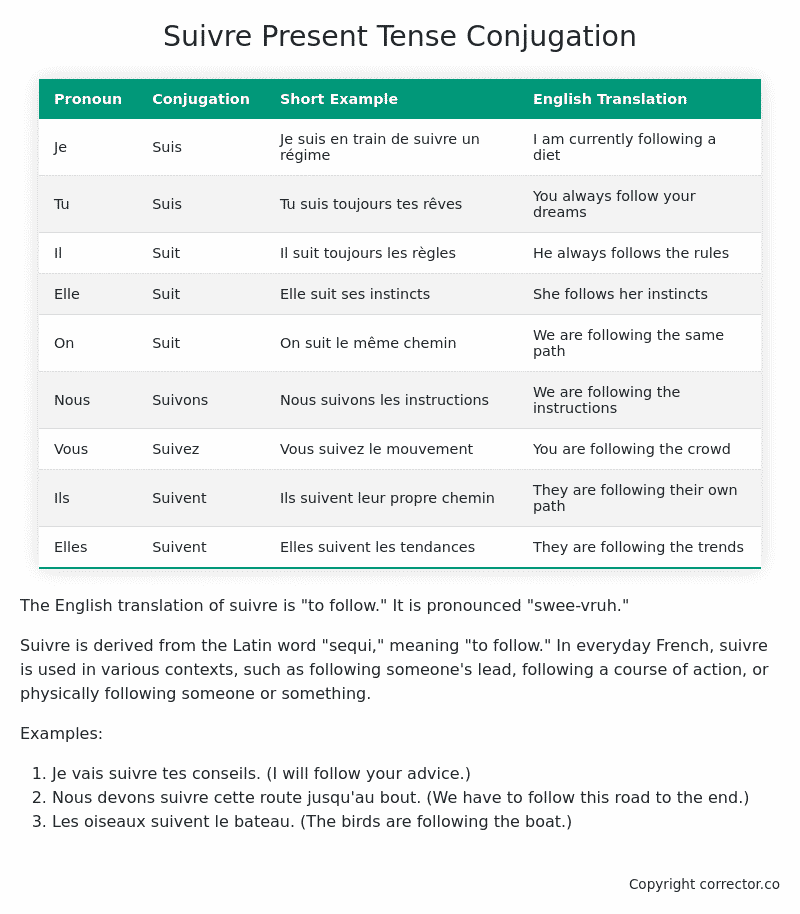Le Present (Present Tense) Conjugation of the French Verb suivre
Introduction to the verb suivre
The English translation of suivre is “to follow.” It is pronounced “swee-vruh.”
Suivre is derived from the Latin word “sequi,” meaning “to follow.” In everyday French, suivre is used in various contexts, such as following someone’s lead, following a course of action, or physically following someone or something.
Examples:
- Je vais suivre tes conseils. (I will follow your advice.)
- Nous devons suivre cette route jusqu’au bout. (We have to follow this road to the end.)
- Les oiseaux suivent le bateau. (The birds are following the boat.)
Suivre – About the French Present Tense
To take a deep dive into all the French tenses then see our article on Mastering French Tense Conjugation.
Common Everyday Usage Patterns For Le Present
Interactions with Other Tenses
Table of the Present Tense Conjugation of suivre
| Pronoun | Conjugation | Short Example | English Translation |
|---|---|---|---|
| Je | Suis | Je suis en train de suivre un régime | I am currently following a diet |
| Tu | Suis | Tu suis toujours tes rêves | You always follow your dreams |
| Il | Suit | Il suit toujours les règles | He always follows the rules |
| Elle | Suit | Elle suit ses instincts | She follows her instincts |
| On | Suit | On suit le même chemin | We are following the same path |
| Nous | Suivons | Nous suivons les instructions | We are following the instructions |
| Vous | Suivez | Vous suivez le mouvement | You are following the crowd |
| Ils | Suivent | Ils suivent leur propre chemin | They are following their own path |
| Elles | Suivent | Elles suivent les tendances | They are following the trends |
Other Conjugations for Suivre.
Le Present (Present Tense) Conjugation of the French Verb suivre (this article)
Imparfait (Imperfect) Tense Conjugation of the French Verb suivre
Passé Simple (Simple Past) Tense Conjugation of the French Verb suivre
Passé Composé (Present Perfect) Tense Conjugation of the French Verb suivre
Futur Simple (Simple Future) Tense Conjugation of the French Verb suivre
Futur Proche (Near Future) Tense Conjugation of the French Verb suivre
Plus-que-parfait (Pluperfect) Tense Conjugation of the French Verb suivre
Passé Antérieur (Past Anterior) Tense Conjugation of the French Verb suivre
Futur Antérieur (Future Anterior) Tense Conjugation of the French Verb suivre
Subjonctif Présent (Subjunctive Present) Tense Conjugation of the French Verb suivre
Subjonctif Passé (Subjunctive Past) Tense Conjugation of the French Verb suivre
Subjonctif Imparfait (Subjunctive Imperfect) Tense Conjugation of the French Verb suivre
Subjonctif Plus-que-parfait (Subjunctive Pluperfect) Tense Conjugation of the French Verb suivre
Conditionnel Présent (Conditional Present) Tense Conjugation of the French Verb suivre
Conditionnel Passé (Conditional Past) Tense Conjugation of the French Verb suivre
L’impératif Présent (Imperative Present) Tense Conjugation of the French Verb suivre
L’infinitif Présent (Infinitive Present) Tense Conjugation of the French Verb suivre
Struggling with French verbs or the language in general? Why not use our free French Grammar Checker – no registration required!
Get a FREE Download Study Sheet of this Conjugation 🔥
Simply right click the image below, click “save image” and get your free reference for the suivre Present Tense tense conjugation!

I hope you enjoyed this article on the verb suivre. Still in a learning mood? Check out another TOTALLY random French verb present conjugation!

